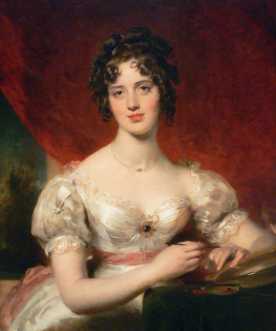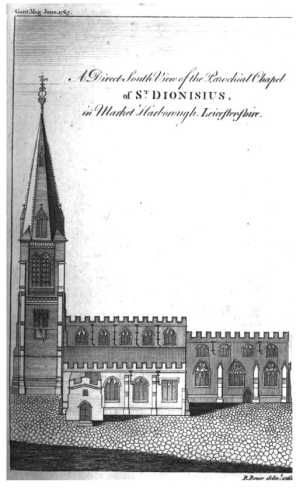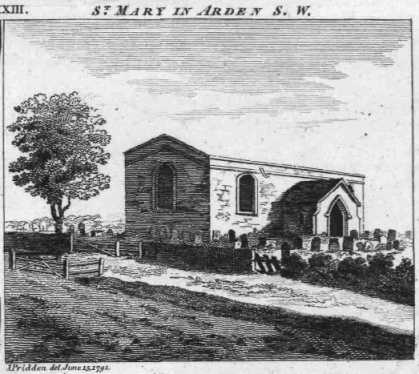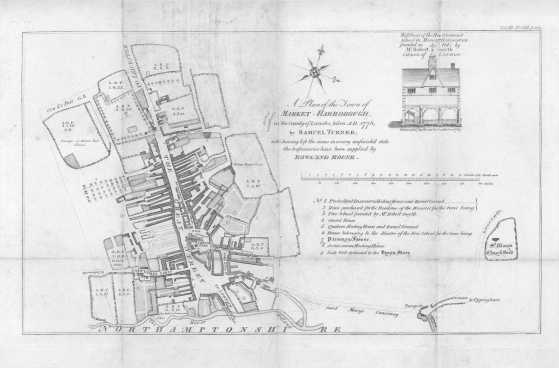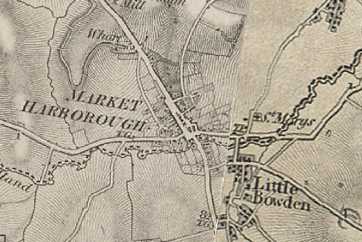Samuel Rouse (c1705–1775) - Family
Samuel Rouse of Market Harborough, draper and amateur astronomer was probably not originally from the town, though it is not known where he was born. He married Susannah Rowland, daughter of William Rowland (c1672–1750) of Pillerton Hersey, Warwickshire. The memorials in St Mary in Arden churchyard include Samuel, his wife (who died in 1793, aged about 86) two children; William Rowland Rouse who died at the age of 4 months in 1738, and Samuel, a lieutenant in the Northamptonshire militia who died in 1777 aged about 44. (Nichols, 1798, p484). Their son Rowland Rouse (c1740-1823) had no children. However, Rowland's sister Susannah (1736/7-1804) married and had several children.
Descendants
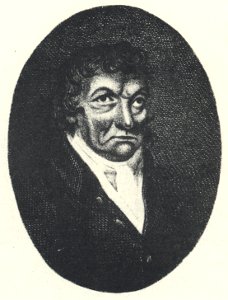 Rowland Rouse (c1739–1823)
|
Rowland Rouse was Samuel Rouse's second son. He was a more successful business man than his father, but he is remembered today for his work on the history of Market Harborough. John Nichols used Rouse's material in The History and Antiquities of the county of Leicester, 1798. |
Samuel Rouse's daughter, Susannah Rouse (1736/7–1804) married Richard Bloxam (1741–1825), who was born in Hinckley. Their eldest son Richard Rouse Bloxam (1765–1840) married Anne Lawrence (1767–1835), sister of Sir Thomas Lawrence (1769–1830), the painter. Richard Rouse Bloxam was under-master at Rugby School for thirty-eight years and rector of Brinklow, Warwickshire and vicar of Bulkington, Warwickshire.
It is likely that Richard Rouse Bloxam (1765–1840), was responsible for a set of cards depicting the constellations called Urania's Mirror c.1825.
Richard Rouse Bloxam's son, (eighth of ten children) Matthew Holbeche Bloxam (1805–1888), was a solicitor and an architectural historian. He built his own three storey house within sight of Rugby School. The description of this house in the Oxford Dictionary of National Biography says, "The only idiosyncrasy in this practical, spacious, yet unpretentious house was a fourth-storey turret from which Bloxam probably studied the stars through his Dolland telescope.
Although he seems to have been keen on accuracy in historical work, Matthew Holbeche Bloxam is the source of the myth that the game of rugby originated with William Webb Ellis picking up the ball during a match in 1823.
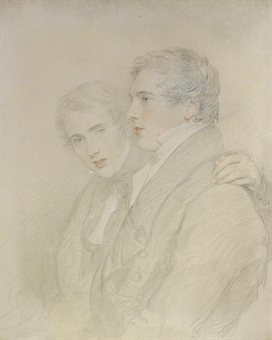 Portrait of Richard Rowland Bloxam and Andrew Bloxam |
Drawing by Sir Thomas Lawrence, 1824, of his nephews, who are Richard Rouse Bloxam's sons and therefore Samuel Rouse's great grandsons. Andrew Bloxam (1801–1878) was born in Rugby. After attending both Cambridge and Oxford Universities, in 1824 he sailed on HMS Blonde as the ship's naturalist on an eighteen month voyage to Hawaii. In 1827 he took holy orders. He married Ann, daughter of the Reverend John Roby, rector of Congerstone, Leicestershire. He was priest in charge at Twycross, Leicestershire from 1839-1871. and rector of Harborough Magna, Warwickshire from 1871-1878. |
|
Portrait of Mary Anne Bloxam, by Thomas Lawrence, c.1824-25 (Wikimedia Commons) |
Mary Anne Bloxam was the daughter of Richard Rouse Bloxam and Ann Bloxam. She married Frederick Hemming. |
Links to other Lawrence Portraits of the Bloxam family
Pencil Drawing - Portrait of Miss Bloxham (Birmingham Museums and Art Gallery)
Susan Bloxam, who died at the age of sixteen.
Churches
|
St Dionisius drawn by Rowland Rouse, 1761. (From The Gentleman's Magazine, June 1765. between pp 284 and 285.) |
Samuel Rouse paid for a wooden clock dial for St Dionysius in 1729. It was removed in 1791 and replaced the following year (Nichols, 1798). He oversaw alterations to the interior of the church in 1751-2 (British History Online: Market Harborough). St Mary in Arden had been the burial place for Market Harborough since the 15th century, if not earlier. However, it suffered storm, and possibly earthquake, damage several times. Also in 1613, after questionable behaviour by the curates, marriages were no longer allowed there and consequently St Mary in Arden and St Dionysius were united. Subsequently, already in a poor state of repair, St Mary became a ruin. It was partially repaired at the end of the seventeenth century, but is now in ruins again (British History Online: Great Bowden). St Dionysius does not have a church yard, hence the burials at St Mary's. |
|
St Mary in Arden, Market Harborough, in 1792. (From Nichols, 1798, opposite p478.) | |
|
Map of Market Harborough in 1776 | |
|
Ordnance Survey Map of Market Harborough. Left section, 1835, right section, 1856.
(From: Ordnance Survey First Series, sheets 63 and 64 at A Vision of Britain through Time.) |
St Mary in Arden is a short distance to the north of Little Bowden. St Dionysius is in the centre of Market Harborough. The Grand Union Canal had not been built in Samuel Rouse's time. Click on images for larger versions. |
References
Albinson, A. Cassandra, Funnell, Peter and Peltz, Lucy (Editors), Thomas Lawrence, Regency Power & Brilliance, Yale Center for British Art and the National Portrait Gallery, 2010. ISBN 978-0-300-16718-4. Andrew Bloxam and Richard Rowland Bloxam portrait, pp176-8.
British History Online:
'Market Harborough', A History of the County of Leicestershire: Volume 5: Gartree Hundred (1964), pp. 133-153. URL: http://www.british-history.ac.uk/report.aspx?compid=22053 Date accessed: 03 October 2012. Church.
'Great Bowden', A History of the County of Leicestershire: Volume 5: Gartree Hundred (1964), pp. 38-49. URL: http://www.british-history.ac.uk/report.aspx?compid=22040 Date accessed: 03 October 2012. St Mary in Arden
Gentleman's Magazine, The, Volume 35, June 1765, "Some Amount of the Parochial Chapel at Market Harborough", pp283-4, Plate between p284 and 285 by R. Rouse.
Davies, J. C., Georgian Harborough, 1969.
Curthoys, M. C. , 'Bloxam, John Rouse (1807–1891)', Oxford Dictionary of National Biography, Oxford University Press, 2004; online edn, Jan 2012 [http://www.oxforddnb.com/view/article/2707, accessed 30 April 2013]: sixth son of Richard Rouse Bloxam (1765–1840)
Harrod, William, The history of Market Harborough, in Leicestershire and its vicinity, 1808. 1776 Map.
Horner, Libby, 'Bloxam, Matthew Holbeche (1805–1888)', Oxford Dictionary of National Biography, Oxford University Press, 2004 [http://www.oxforddnb.com/view/article/2708, accessed 30 April 2013]: eighth of the ten children of Richard Rouse Bloxam (1765–1840)
Jackson, B. D. , 'Bloxam, Andrew (1801–1878)', rev. Giles Hudson, Oxford Dictionary of National Biography, Oxford University Press, 2004; online edn, Jan 2012 [http://www.oxforddnb.com/view/article/2706, accessed 30 April 2013]: fourth son of Richard Rouse Bloxam (1765–1840)
Thomas Lawrence (Wikipedia)
Nichols, John, The History and Antiquities of the county of Leicester, vol 2 part 2, 1798: Rouse family monumental inscriptions at St Mary in Arden and account of life by son, Rowland p484, determination of the latitude and longitude of Market Harborough p486, paid for church clock dial, 1729 p495, c1732 listed births, marriages and deaths for previous hundred years p499. drawing of St Mary in Arden opposite p478 drawing of St Dionysius opposite p494
Last updated 29th May, 2013.

